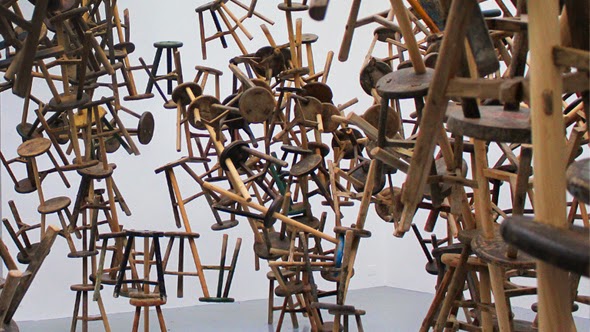A
AI WEIWEI’ S BANG INSTALLATION AT VENICE ART BIENNALE 2013
A
AI WEIWEI’ S BANG INSTALLATION AT VENICE ART BIENNALE 2013
Upon Ai Weiwei's return to China (he lived abroad in the U.S. from 1981
until 1993), he began researching the artistic and cultural traditions of his
native country a pursuit which had been prohibited since the cultural
revolution. Collecting and studying various Chinese antiques, he started
integrating the customary objects and furniture pieces into his own creative
practice as a means of addressing the export of cultural values and historical
knowledge in the context of art.
In China, every family typically has at least one stool which serves a
range of purposes and that is passed down through each generation; each one of
the wooden three-legged structures having been manufactured in a uniform and
used across all sectors of society for centuries. However, following the
cultural revolution, the production of the simple objects dropped and metal and
plastic became standard materials for furniture construction. For the 2013 Venice Art Biennale, Ai Weiwei's work 'bang' employs 886-three legged wooden stools made by
traditional craftsmen whose expertise is now something that is rare to find,
and has installed an expansive rhizomatic structure which speaks of the
increasing volumes of organisms in our world's megacities. The single stool can
be interpreted as a metaphor for the individual, and its relation to an
overarching and excessive system in a postmodern world which is developing
faster than it can keep up with. The production of art in Germany today is
defined by various forms of collaboration between artists from all over the
world and by an intellectual and cultural climate that is profoundly
international. Curator Susanne Gaensheimer therefore intends to continue her
critical examination of the meaning of traditional forms of 'national
representation' in 'national pavilions' in the German Pavilion at this year’s
Venice Biennale.
Proposing that the nationally defined format be treated as an open concept
and that Germany be understood not as a hermetic entity, but as an active
participant in a complex, worldwide network, she invited four artists of
international renown from four different countries to contribute of which Ai
Weiwei is one of them. The other three are:
Romuald Karmakar
Santu Mofokeng
Dayanita Singh
Romuald Karmakar
Santu Mofokeng
Dayanita Singh
At the initiative of the French and German foreign offices, this year’s
German Pavilion is housed in the French Pavilion, and vice versa.
Curator:
Susanne Gaensheimer
Susanne Gaensheimer
Project Director:
Anna Goetz
Anna Goetz
Commissioned by:
The German contribution is realized on behalf of the federal foreign office
and in cooperation with the Institut Für Auslandsbeziehungen (ifa).
The German contribution is realized on behalf of the federal foreign office
and in cooperation with the Institut Für Auslandsbeziehungen (ifa).
Supporters of the German Pavilion:
The Goethe - Institut and the IFA
The Goethe - Institut and the IFA
http://www.designboom.com/art/ai-weiwei-bang-installation-at-venice-art-biennale-2013/?utm_campaign=daily&utm_medium=e-mail&utm_source=subscribers
You may visit Ai Weiwei's another exhibition news at Martin-Gropuis-Bau to click below link of my blog.
http://mymagicalattic.blogspot.com.tr/2014/06/ai-weiweievidence-at-martin-gropius-bau.html
You may visit Ai Weiwei's another exhibition news at Martin-Gropuis-Bau to click below link of my blog.
http://mymagicalattic.blogspot.com.tr/2014/06/ai-weiweievidence-at-martin-gropius-bau.html
A
A
A
AI WEIWEI
Ai Weiwei is
an artist and a social activist. His work encompasses diverse fields including
fine arts, curating, architecture, and social criticism. Born in Beijing in
1957, he moved to Xinjiang with his family between 1960 and 1976. Subsequently
he relocated to the United States in 1981 and lived there until 1993. He
currently resides and works in Beijing.
On April 3,
2011, Ai was secretly detained by the police for 81 days at the Beijing Capital
International Airport while on his way to board a flight to Hong Kong. He was
released on bail on June 22, 2011 upon fabricated tax charges. Although the
bail was lifted after a year, the authorities have not returned his passport
and he remains prohibited from travelling outside China.
In
collaboration with Herzog & de Meuron, Ai Weiwei designed the 2012
Serpentine Pavilion in London, UK. Among numerous awards and honors, he won the
Václav Havel Prize for Creative Dissent from the Human Rights Foundation in
2012, and was selected as Honorary Academician at the Royal Academy of Arts,
London, UK in 2011.
His major
solo exhibitions include Ai Weiwei: According to What? at the Hirshhorn Museum
and Sculpture Garden, Washington D.C. (2012), Ai Weiwei: Absent at the Taipei
Fine Arts Museum, Taipei, Taiwan (2011), Circle of Animals at the Pulitzer
Fountain, New York, NY (2011), Interlacing at Fotomuseum Winterthur,
Winterthur, Switzerland (2011), The Unilever Series: Ai Weiwei at the Tate
Modern, London, UK (2010), So Sorry at Haus der Kunst, Munich, Germany (2009),
and Ai Weiwei: New York Photographs 1983-1993 at Three Shadows Photography Art Center,
Beijing (2009).










.jpg)






















